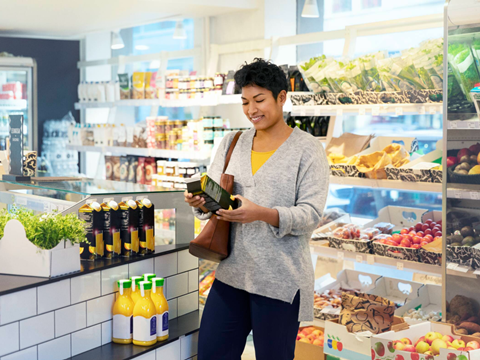
In honour of Earth Day 2024, Marjukka Kujanpää, director of Sustainability at Stora Enso Packaging Materials, spoke to us about the importance of transparent communication to navigate the nuances of reusable packaging solutions – the materials used, the cleaning process, disposal at end-of-life, and the suitability of a reusable pack for specific applications.
This Earth Day, and in an era where environmental consciousness is a top priority, consumers are increasingly drawn to brands that embrace sustainability. The intentions of consumers are clear: minimize environmental damage and contribute to a greener future.
On the whole, brand owners are answering the call of the many consumers who care about sustainability, particularly around times like Earth Day when environmental issues are at the forefront of public discourse. With new stories every day about the amount of waste consumers are producing, brand owners must continue to respond with action to the urgency of the climate and circularity crisis.
The risks of getting it wrong are real. Failing to adequately justify their sustainability claims might not only damage a brand’s reputation, but their bottom line too. And so, without clear communication, brand owners risk a loss of trust and confidence.
However, navigating the complex labyrinth of guidelines and rules for green products and packaging can be an overwhelming task for both brand owners and consumers, making choosing the right materials less than straightforward. For example, reusable packaging could be a viable, sustainable option for brand owners and consumers. Whilst consumers are generally open to reusing, they are confused about how it works in practice, including how cleaning is performed to ensure food safety, and how convenient it is to return containers for refilling. This can become a communication obstacle for brand owners looking to spearhead this approach.
End-of-life: even reusable doesn’t last forever
As we reflect on our environmental decisions this Earth Day, it’s crucial that brand owners consider the environmental impact of the packaging throughout its life cycle, being open to both reusable and disposable recyclable formats where each makes the most sense.
However, in spite of its name, reusable packaging cannot be reused indefinitely, and in cases of food where hygiene standards are understandably high, plastic has to be regularly inspected and replaced when scratched, and recycled when disposed of. Even ceramic dishes don’t last forever, and are both easily broken and not easily recyclable. Not only this, but the environmental impact of ceramics is vast, across mining, shipping, and then firing, the production process is extremely energy-intensive.
In the context of Earth Day’s focus on comprehensive environmental impacts, testing and science-based evaluation, like Life Cycle Assessment (LCA), play a crucial role. Brand owners are facing high demands from their customers, but shouldn’t feel pressure to over-promise and under-deliver on sustainability claims for their packaging choices and their end-of-life disposal systems.

Marjukka Kujanpää, director of Sustainability
Keeping clean
As we look to implement more reusable systems, consumers rightly prioritize their health, questioning the hygiene and safety of reusable containers, particularly in the cases of food. In fact, 78% of consumers raise this issue, making it one of the most common obstacles to adoption. And it’s not just a problem for consumers; reusable packaging can face stricter scrutiny or require more complex compliance measures compared to single-use alternatives, which is a significant barrier for some brand owners.
Consumer concerns often stem from a lack of information or confusion about different types of reuse systems. To overcome this, brand owners and retailers must communicate transparently about the materials used, cleaning procedures, and efforts to discard unfit packages. Furthermore, education about initiatives like Earth Day’s campaign to reduce plastic usage by 60% by 2040 can motivate consumers and brand owners alike to adopt and support more sustainable practices.
And one thing’s for sure: consumers are more likely to listen to new information from a brand they trust, with research suggesting they’re twice as likely to stay loyal to a brand they have confidence in. So, the importance of maintaining an authentic and reliable image cannot be overstated. Alongside communicating the safety measures being taken in-store and beyond, brand owners need to work to upkeep hard-earned customer loyalty, ensuring that customers can trust the brands with whom they spend their money.
Convenience: Balancing consumer needs with Earth Day ideals
In the fast-paced world we live in, convenience is crucial for consumers, with many considering it a necessity rather than a luxury. For example, almost a quarter of consumers agree that it would take too much effort to return packaging to the point of purchase. This perceived burden can leave packagers and retailers questioning whether consumers will fully embrace reusable packaging and if adopting these schemes even makes financial sense.
Meanwhile, schemes that mitigate the onus on consumers are already underway. After launching in New York in 2023, Uber Eats announced this month that it’s extending its trial of home collection of reusable and returnable packaging to the US’ West Coast. When finished with their food containers, customers can arrange a day for collection or return to restaurants at their next convenience.
Another comparable option could be inner-city office workers who often visit the same restaurant or café for lunch bringing their own container and taking it home to clean before bringing it back the next day – much like Starbucks’ reusable cup initiative, which has been in place since 2018, where a small ‘latte levy’ is even added for anyone not using reusable alternatives.
So, the convenience barrier, often highlighted in discussions around Earth Day, is clearly not insurmountable, and it provides an exciting opportunity for brand owners to educate their customers, and lead a paradigm shift in consumer behavior towards reusable packaging. Having said this, while there are circumstances that naturally lend themselves to reusable packaging, there are many where it’s not the most practical or desirable, and finding that balance will be crucial for brands navigating this changing landscape.
Communication: a cornerstone of Earth-Day inspired packaging innovation
It’s clear, then, that communication will play a key role in overcoming some of the barriers to reusable packaging roll-out and adoption. And with confusion still rife amongst consumers, the brand owners who are able to deliver concise and authentic messaging around the safety, sustainability, and convenience of all of their solutions, reusable or otherwise, will come out on top.
Not only this, but an element of collaboration across the entire retail ecosystem, from supermarkets to brand owners and packaging designers, will help to push out this communication and expedite the take-up and integration of the most suitable solutions for a more circular future.
As Earth Day reminds us of our shared responsibility to the planet, effective communication becomes even more essential in overcoming barriers to sustainable practices like reusable packaging.
If you liked this story, you might also enjoy:
The Brief: How viable is biorecycling for plastics?
Report: How the top brands are progressing on packaging sustainability
The Brief: Using ocean-bound plastic in packaging – how, why and should we?

















No comments yet